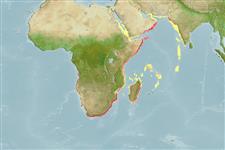>
Eupercaria/misc (Various families in series Eupercaria) >
Sparidae (Porgies)
Etymology: Diplodus: Greek, diploos = twice + Greek, odous = teeth (Ref. 45335).
Environment: milieu / climate zone / profondeur / distribution range
Écologie
marin récifal; profondeur 0 - 50 m (Ref. 27121). Tropical; - 35°S
Southeast Atlantic and Western Indian Ocean: Angola to Mozambique and southern Madagascar, possibly reaching Mauritius (Ref. 3168, 3198).
Length at first maturity / Taille / Poids / Âge
Maturité: Lm 21.1 range ? - ? cm
Max length : 45.0 cm TL mâle / non sexé; (Ref. 3198); common length : 30.0 cm TL mâle / non sexé; (Ref. 3507); âge max. reporté: 21 années (Ref. 26244)
Description synthétique
Clés d'identification | Morphologie | Morphométrie
Épines dorsales (Total) : 12; Rayons mous dorsaux (Total) : 14 - 15; Épines anales: 3; Rayons mous anaux: 13 - 14. Young specimens with fine crossbars; large adults almost uniformly black.
Body shape (shape guide): fusiform / normal.
Adults occur in shallow rocky and sandy substrate; juveniles in shallow reefs, estuary mouths and intertidal pools, sandy beach surf zone. Omnivorous on seaweeds, sponges and bivalves. Also feeds on crustaceans, worms, mollusks, and fish. Sold fresh or whole and as bait.
Life cycle and mating behavior
Maturité | Reproduction | Frai | Œufs | Fécondité | Larves
Bauchot, M.-L. and J.-C. Hureau, 1990. Sparidae. p. 790-812. In J.C. Quero, J.C. Hureau, C. Karrer, A. Post and L. Saldanha (eds.) Check-list of the fishes of the eastern tropical Atlantic (CLOFETA). JNICT, Lisbon; SEI, Paris; and UNESCO, Paris. Vol. 2. (Ref. 3688)
Statut dans la liste rouge de l'IUCN (Ref. 130435: Version 2025-1)
Menace pour l'homme
Harmless
Utilisations par l'homme
Pêcheries: intérêt commercial mineur; pêche sportive: oui; appât: usually
Outils
Articles particuliers
Télécharger en XML
Sources Internet
Estimates based on models
Preferred temperature (Réf.
123201): 18.6 - 27, mean 25.9 °C (based on 56 cells).
Phylogenetic diversity index (Réf.
82804): PD
50 = 0.5000 [Uniqueness, from 0.5 = low to 2.0 = high].
Bayesian length-weight: a=0.01514 (0.00959 - 0.02388), b=3.08 (2.95 - 3.21), in cm total length, based on LWR estimates for this species & Genus-body shape (Ref.
93245).
Niveau trophique (Réf.
69278): 2.7 ±0.15 se; based on food items.
Generation time: 7.7 ( na - na) years. Estimated as median ln(3)/K based on 2
growth studies.
Résilience (Réf.
120179): Milieu, temps minimum de doublement de population : 1,4 à 4,4 années (tm=3; tmax=21).
Fishing Vulnerability (Ref.
59153): Moderate vulnerability (38 of 100).
🛈
Nutrients (Ref.
124155): Calcium = 50.6 [25.9, 83.1] mg/100g; Iron = 0.626 [0.349, 1.128] mg/100g; Protein = 19.4 [18.2, 20.6] %; Omega3 = 0.127 [0.067, 0.248] g/100g; Selenium = 33.1 [18.4, 56.2] μg/100g; VitaminA = 63 [18, 194] μg/100g; Zinc = 1.35 [0.92, 1.85] mg/100g (wet weight);
